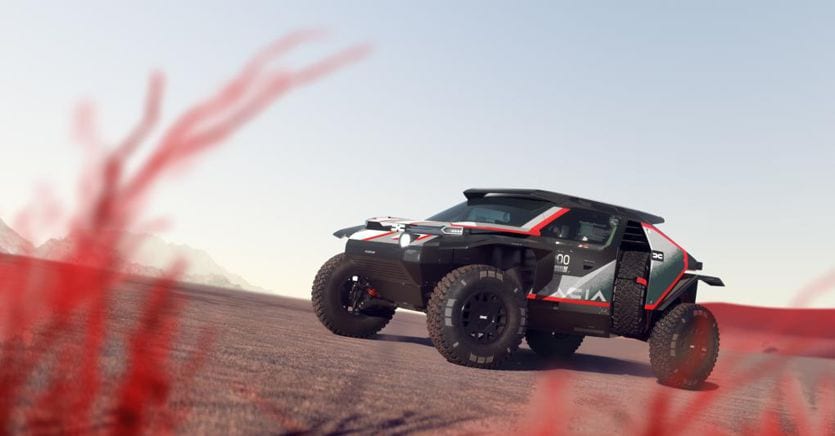Listen to the audio version of the article
Born to win. Dacia Sandrider is a prototype designed by the brand’s designers together with the drivers and co-drivers who will participate in the most challenging rally raid in the world in 2025: the Dakar.
Sandrider: inspired by the Manifesto concept car
Inspired by the Manifesto concept car, Dacia’s laboratory of ideas presented in 2022, Sandrider is a new vehicle specially designed for rally raids, making use of the sporting expertise of Renault Group and being able to count on the teams of Prodrive, a British company specialized in motorsport that already this year he participated in the Dakar with the Hunter T1+. Aramco is also added to these partners for the use of synthetic fuel.
Sandrider ingeniously exploits all the possibilities offered by the regulations of the Ultimate T1+ category, focuses on agility and lightness and precisely responds to the essential needs of pilots and co-pilots. The latter have been actively involved since the genesis of Sandrider. Before the many planned test sessions and from the early stages of the work, they contributed by transmitting their rich experience to the designers and engineers, especially with very concrete design sessions using virtual reality.
Sandrider: essential style
Designed by Dacia designers, the Sandrider’s exterior styling focuses on the essentials: only the body panels considered absolutely necessary have been retained. It is devoid of decorative elements and therefore superfluous. Naturally, special attention was paid to aerodynamics.
From this perspective, which focuses on the essential needs of the pilot and co-pilot, the short, sloping and floating front bonnet disappears from the crew’s field of vision.
The use of anti-reflective paint (a technique taken from aviation) applied to the upper part of the dashboard also optimizes the visibility of the pilot and co-pilot.
To design the cockpit, the designers and engineers focused above all on listening to the needs, habits and constraints of the pilots and their co-pilots. Sandrider stands out, therefore, for its modular dashboard which allows each individual crew to adapt the ergonomics and arrangement of some elements as desired according to their preferences.
Sandrider: design features
Clearly, this involves the overall consolidation of the vehicle, with reinforced underbody and bumpers, carbon bodywork, but also suspension (double triangle) and 4X4 transmission suitable for the extreme conditions of rally raids. The innovative electrical system will allow all on-board accessories to maintain optimal power, even in extreme conditions.
In addition to these fundamental design elements, Sandrider has a rugged and outdoor approach even to things that may seem like details, but which, in reality, make the lives of crews a lot easier. Sabelt seats are covered with specific, antibacterial fabrics that regulate humidity. The spare wheels are not faired to make them easier to use. Likewise, the crew can have quick access to on-board tools, without having to manage a special box. An example: the fixing nuts can be placed on a special magnetic surface integrated into the bodywork in case they need to be removed, thus avoiding losing them in the sand. A measure inspired by the experience of a Dacia driver.
Sandrider can count on the latest generation of BF Goodrich tires which guarantee optimal grip on all surfaces, with maximum resistance even to impacts and punctures.
Sandrider: eco-smart approach
The engineers worked particularly on lightness to reduce fuel consumption. The total weight of Sandrider has decreased by around 15 kg compared to comparable prototypes, using a lighter tubular chassis, eliminating all superfluous body panels and adopting carbon for the others, dispensing with all decorative elements and opting for a more compact and less heavy engine. To optimize the traction and dynamic behavior of the Sandrider, the weight distribution between front and rear has been significantly increased at the front.
Sandrider is equipped with a 3-litre V6 twin-turbo direct injection engine with 360 hp (265 kW) and 539 Nm of torque.
Again to reduce fuel consumption and improve performance at the same time, Sandrider’s aerodynamics have been given particular attention. The engineers managed to reduce drag by 10 percent and lift by 40 percent compared to comparable prototypes. While carrying out this work, special attention was paid to the air intakes needed to cool the engine; in fact, in the extreme conditions of the Dakar and rally raids, heat management is an element of fundamental importance. To ensure that the temperature in the interior does not rise too high, the designers added pigments that act against infrared rays directly into the carbon fiber of the vehicle, a process for which a patent has been registered.
Sandrider is equipped with an engine powered by synthetic fuel supplied by Aramco.
He Team Dacia Sandriders
The official Dacia team of the World Rally-Raid Championship will be made up of three crews with heterogeneous experiences and will participate in its first Dakar and all the Championship races in 2025.
The crews will be made up of Sébastien Loeb and Fabian Lurquin, Nasser Al-Attiyah with a co-driver still being chosen and Cristina Gutierrez Herrero together with Pablo Moreno Huete.
After important months dedicated to testing, the first outing will be in October for the Morocco Rally.
